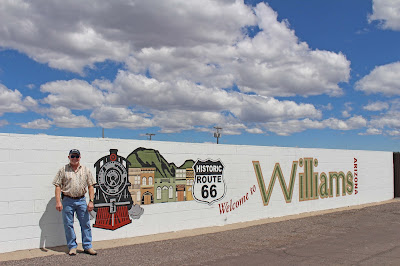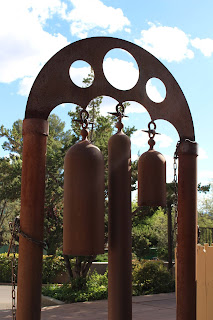We arrived at the Circle
Pines KOA RV Park on April 24, 2015 and stayed for five days. We heard about
Williams from another RVer and it was a great place to stay. It’s springtime, but the day we arrived, it
snowed! Just our luck! But it was beautiful, as long as we didn’t have to drive
the RV in it! Mike even made a snowman for Sharon!
WILLIAMS,
AZ
Williams is
located just north of Phoenix and west of Flagstaff and is known as the “Gateway
to the Grand Canyon.” It is located in
the heart of the Kaibab National Forest at an elevation of 6,770 feet and
serves as the forest’s headquarters. Williams was also the last town in America
on Historic Route 66 to be bypassed by the freeway. Interstate 40 replaced the last surviving
segment on October 13, 1984.
Founded in 1880, Williams was named for the famous trapper, scout and mountain man, “Old Bill Williams,” whose statue stands at the west end of the city. The large mountain directly south of town is named Bill Williams Mountain.
We strolled along the antique brick side-walks of Historic Old Town which was full of interesting shops, galleries and restaurants. You can also ride the rails on a historic steam train to the South Rim of the Grand Canyon. We spent a lot of time in a corner gallery store that offered a lot of unique art.
Then we ate at Twisters
Soda Fountain and Route 66 Café all decked out in pink and 50’s motif. When we
arrived, a parade of vintage cars pulled up to Twisters. They were members of the
Horseless Carriage association. After lunch we admired the beautifully restored cars!
JEROME,
AZ
Jerome is a mine
town propped on a thirty-degree mountainside two thousand feet above the Verde
Valley floor a short drive from Williams. Few towns, if any, are more
precariously anchored on an inclined plane. The town’s main streets are
switchbacks in an arterial highway that snakes over Mingus Mountain. Fifteen
hundred vertical feet separate the upper-level houses from the lowest dwellings
in the Gulch. It was once known as the “Wickedest
Town in the West.”
The first mine claims were staked on an ore body west of town back in the days of horses, mules, and burros, when this rugged mountain was without a road. It was natural for those early prospectors and miners to camp close to the diggings. The diggings grew into one of the greatest copper-producing mines in the world, and the camp grew into the fabulous “city” of Jerome which was once populated by nearly 15,000 residents during the height of the copper mining business.
It was quirky little town that has one fire station, lots of galleries and restaurants. We ate at the Mile High Grill which was delicious!
Jerome is Arizona’s
Art Destination and it’s true, the galleries and studios were filled with every
kind of creative art you could think of. We stopped in at the glass studio and
watched the artist in motion.

We also drove through the Gold King Mine Ghost Town filled with antique trucks, tractors and construction and mining equipment dating back to the turn of the century.
Here is Where the Pavement Ends, The Old West Begins…
We took a scenic
drive to Sedona. It was a beautiful sunny day with blue skies filled with a
wondrous display of clouds.
Early Native Americans built cliff dwellings in Sedona around 1100 A.D., but Sedona was named for the wife of the area’s first U.S. postmaster, T.C. Schnebly. Surrounded by soaring red-rock monoliths, the city is best known for its enchanting views. The shapely sandstone rock formations give off a red-orange glow, and verdant plant life – from red-limbed manzanita to alligator juniper – adds to the mystique.
We typically do not return to places we have already been, but it had been years, so we decided to return. When we arrived in Sedona, we didn’t recognize it since we last visited on a vacation out West with our friends Dan and Karin. Today, the town had grown to a tourist attraction with traffic congestion and lots of stores and restaurants. But the iconic red canyon rock landscapes were as beautiful as we remembered. And the artwork amazing!
Schnebly Hill Road
– A hair-raising “shortcut” Mike found that we traversed at night in a minivan,
only to find out the next morning at breakfast that it was a dirt trail used
for off-road Jeep tours! It was so dark that Mike came inches to the edge of
the cliff and turned sharply to avoid driving off. And the road was so rugged
and full of curves that Sharon and Dan cursed Mike while their stomachs churned
from nausea.
Center for the New Age – A throwback to the Hippie days with all things spiritual, crystal and having to do with the vortex.
Tlaquepaque – Sedona’s Art and Shopping landmark since the 1970s. Today its boundaries enclose more than 40 shops featuring one-of-a-kind. Giant sycamores and stately cottonwoods dapple the light that falls on Tlaquepaque’s masonry walls as you walk through four different courtyards.
On another day we drove back to Sedona to meet our friends, Bob and Jackie from Payson, AZ. It was a cloudy, rainy day but it was fun to walk between the raindrops, have lunch and visit with them.
Join us for our
next blog as we travel to Gallup, New Mexico on our way to Colorado.
Mike & Sharon
“One today is worth two tomorrows.”
Benjamin Franklin (1706-1790)




































































































